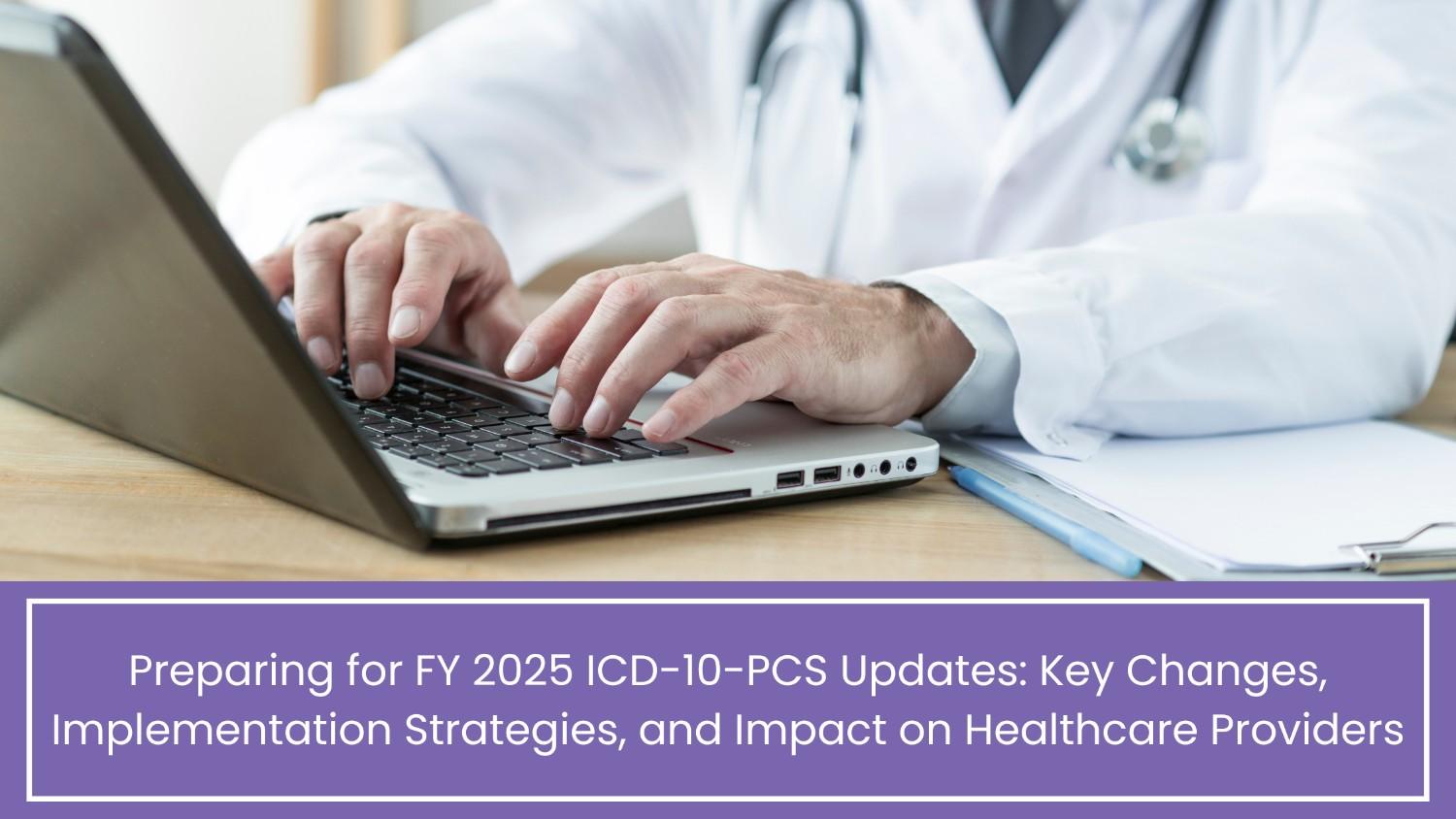FY 2025 ICD-10-PCS Updates: Key Changes & Implementation Tips
Stay ahead with the FY 2025 ICD-10-PCS updates by understanding key changes, implementation strategies, and their impact on healthcare providers. These updates affect medical coding accuracy, reimbursement, and compliance. Learn how to integrate new procedure codes, avoid coding errors, and streamline revenue cycle management. Proper preparation ensures smoother claims processing and minimizes denials. Stay compliant with CMS guidelines and enhance operational efficiency with these essential FY 2025 ICD-10-PCS updates. Get expert insights to optimize your coding workflows.
Table of Contents
Preparing for FY 2025 ICD-10-PCS Updates: Key Changes, Implementation Strategies, and Impact on Healthcare Providers
The world of healthcare is changing continuously just like the ICD-10-PCS code set. Changes in medical technologies and procedures are reflected in their yearly updates. For medical professionals to continue coding accurately and meet regulations, they need to understand the ICD-10-PCS update for FY 2025 which has significant implications. This article delves into the major changes, how they affect healthcare practitioners as well as how best to use them.
The International Classification of Diseases, 10th Revision – Procedure Coding System serves as an important tool used especially by United States institutions for effective coding of inpatient hospital services. Accurate coding ensures effective documentation, medical billing, and payment processes which essentially affect the financial health of providers together with their compliance with various regulations. Therefore, given these existing updates for 2025, which are expected to come into force from October 1st, 2024; it is clear that healthcare organizations must act in readiness for those changes to minimize disruptions and retain coding accuracy.
Key Changes in FY 2025 ICD-10-PCS
The FY 2025 update brings about 371 new codes, and 61 code deletions, and poses no revisions to current codes. These updates majorly affect surgical and medical procedures, focusing on enhancing the specificity of the reported inpatient procedures.
Medical and Surgical Procedure Codes
Destruction of Brain Using Stereo electrogenic philographic Radiofrequency Ablation: The previous code 00503ZZ is replaced by the new 00503Z4, delivering more accurate documentation for this intricate procedure.
Brain Mapping Using Connectomic Analysis: The new code 00K0XZ1 enables detailed coding for brain mapping procedures conducted using external connectomic analysis, outlining innovations in neuroimaging approaches.
Hepatic and Splenic Artery Bypass: The 041 table for procedures has 20 new codes added to it. It includes bypasses from splenic or hepatic arteries to lower arteries. These inclusions reflect the rising requirement for accurate coding for vascular surgeries.
Popliteal/Arterial/Femoral Dilation with Drug-Eluting Intraluminal Device: This shift brings about 40 new codes in the 047 table of procedures for the dilation of several arteries, improving the specificity of services that include drug-eluting tools.
Bypass of Lymphatic and Hemic Systems: The most comprehensive inclusion is the new root operation table of 071, which involves codes for bypass procedures within hemic and lymphatic systems, highlighting the growing intricacy and significance of these procedures
Other Notable Additions: This change also involves codes for deletion or revision of drainage tools from the pancreas or the gallbladder, replacement of breast tissue using lumbar artery perforator flaps, and the revision or deletion of external fixation tools from facial or nasal bones.
New Technology Codes
- Improvements in medical innovations have resulted in the creation of various ICD-10-PCS codes, allowing more accurate reporting of innovative services or procedures.
- Destruction of Renal Sympathetic Nerve(s) Using Radiofrequency Ablation: The New Technology Group 10 includes the code X05133A, highlighting the use of radiofrequency ablation in renal procedures.
- Division of Aortic Valve Using Intraluminal bio-prosthetic Valve Leaflet Splitting Technology: A leading-edge procedure for aortic valve treatment uses bio-prosthetic innovation.
- Administration Codes for Bentracimab: Newly introduced codes XW0333A and XW0433A in the XW0 table, covers the bentracimab administration, a novel therapeutic agent.
- In addition, various old dilation codes in X27 have been removed to accommodate new codes that elaborate advanced products leveraged in these procedures.
Impact on Healthcare Providers
- The FY 2025 ICD-10-PCS updates will have profound implications for healthcare providers, especially in billing, documentation, and reporting areas.
- The new codes deliver major specificity, resulting in more precise billing and possibly higher reimbursement rates. However, this also reflects the diligence of coders in selecting accurate codes to alleviate audits and denials.
- Providers must validate their documentation precisely to highlight the procedures performed, as the new codes require detailed clinical information.
- Specialties like neurosurgery, cardiology, and vascular surgery frequently perform procedures associated with newly updated codes. They will necessitate special attention to ensure precise coding and billing.
Challenges
- The introduction of new codes, removal of older codes, and such will necessitate comprehensive training for medical coders and healthcare staff to guarantee their familiarity with the updates and their proper application.
- Healthcare providers may encounter concerns about updating Electronic Health Record systems and coding software to include new codes.
Implementation Strategies
For the effective transition of FY 2025 ICD-10-PCS updates, healthcare providers must consider various aspects:
- Employ training sessions, workshops, and webinars to educate coding staff, administrative personnel, and clinicians on the new codes and their challenges.
- Utilize resources including industry seminars, coding manuals, and online tools to stay abreast on the latest updates and best implementation practices.
- Ensure EHR systems and coding software are updated to accommodate the latest ICD-10-PCS codes. Test these systems regularly to recognize and resolve issues before updates go live.
- Conduct audits regularly for coding practices to guarantee that the latest codes are applied accurately and that the documentation is precise and complete.
The Role of Technology in Adapting to Changes
As the ICD-10 updates are becoming increasingly intricate, the role of technology in backing healthcare providers cannot be underestimated. Innovative billing solutions can aid in the automatic accurate coding based on clinical documentation, minimizing the probability of mistakes and fastening the coding workflows.
Integrated EHR solutions with up-to-date coding software to optimize coding workflows and enhance accuracy. Update EHR systems regularly to outline shifts in coding aspects, and perform system audits to guarantee compliance with the latest standards.
Winding Up
The FY 2025 ICD-10-PCS updates highlight opportunities and hurdles for healthcare providers. By being prepared to face the challenges of using technology and investing in education and training, providers can validate a smooth upgrade to the latest codes and maintain compliance with industry regulations. Proactive preparedness will improve the precision of medical coding and support better patient outcomes and financial stability.
Healthcare organizations must stay current to maintain competence and remain compliant in the ever-evolving landscape. With proper techniques and devices, providers can explore the complex terrain of medical coding updates and provide high-quality patient care.
ALSO READ – Ready to Level Up? It Starts with Your Credentials
Talk to Medical Billing Expert Today — Get a Free Demo Now!






